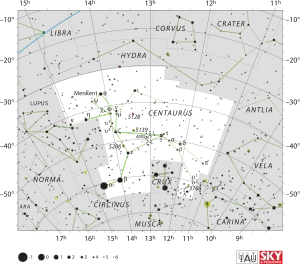
| |
| Observation data Epoch J2000.0 Equinox J2000.0 | |
|---|---|
| Constellation | Centaurus |
| Right ascension | 11h 34m 45.66s[1] |
| Declination | −54° 15′ 50.7″[1] |
| Apparent magnitude (V) | +4.62[2] |
| Characteristics | |
| Evolutionary stage | Main sequence[3] |
| Spectral type | B9V[4] |
| U−B color index | −0.21 |
| B−V color index | −0.077±0.005[2] |
| Astrometry | |
| Radial velocity (Rv) | +5.7±2.2[2] km/s |
| Proper motion (μ) | RA: −56.17±0.18[1] mas/yr Dec.: 16.19±0.20[1] mas/yr |
| Parallax (π) | 7.65 ± 0.22 mas[1] |
| Distance | 430 ± 10 ly (131 ± 4 pc) |
| Absolute magnitude (MV) | −0.96[2] |
| Details | |
| Mass | 3.58±0.05[3] M☉ |
| Radius | 2.4–3.1[5] R☉ |
| Luminosity | 306[3] L☉ |
| Temperature | 10,600[3] K |
| Rotational velocity (v sin i) | 160[3] km/s |
| Other designations | |
| Database references | |
| SIMBAD | data |
A Centauri is a single[7] star in the southern constellation of Centaurus. It is blue-white in hue and is faintly visible to the naked eye with an apparent visual magnitude of +4.62.[2] The star is located at a distance of approximately 430 light-years from the Sun based on stellar parallax.[1] It appears to be drifting further away with a radial velocity of around +6 km/s.[2]
This is a rapidly rotating Be star, showing an emission-line spectrum on top of the normal absorption spectrum of the star, due to a circumstellar disk of ejected matter. It doesn't show any absorption lines from the disk.[8] It is a B-type main-sequence star with a stellar classification of B9V.[4]
References
- 1 2 3 4 5 6 van Leeuwen, F. (2007). "Validation of the new Hipparcos reduction". Astronomy and Astrophysics. 474 (2): 653–664. arXiv:0708.1752. Bibcode:2007A&A...474..653V. doi:10.1051/0004-6361:20078357. S2CID 18759600. Vizier catalog entry
- 1 2 3 4 5 6 Anderson, E.; Francis, Ch. (2012). "XHIP: An extended hipparcos compilation". Astronomy Letters. 38 (5): 331. arXiv:1108.4971. Bibcode:2012AstL...38..331A. doi:10.1134/S1063773712050015. S2CID 119257644.
- 1 2 3 4 5 Zorec, J.; Royer, F. (January 2012). "Rotational velocities of A-type stars. IV. Evolution of rotational velocities". Astronomy & Astrophysics. 537: A120. arXiv:1201.2052. Bibcode:2012A&A...537A.120Z. doi:10.1051/0004-6361/201117691. S2CID 55586789.
- 1 2 Houk, Nancy; Cowley, A. P. (1979). Michigan catalogue of two-dimensional spectral types for the HD stars. Vol. 1. Ann Arbor, Michigan: Department of Astronomy, University of Michigan. Bibcode:1978mcts.book.....H.
- ↑ Pasinetti Fracassini, L. E.; et al. (2001). "Catalogue of Apparent Diameters and Absolute Radii of Stars (CADARS)". Astronomy & Astrophysics (Third ed.). 367 (2): 521–24. arXiv:astro-ph/0012289. Bibcode:2001A&A...367..521P. doi:10.1051/0004-6361:20000451. S2CID 425754.
- ↑ "A Cen". SIMBAD. Centre de données astronomiques de Strasbourg. Retrieved 2020-02-27.
- ↑ Eggleton, P. P.; Tokovinin, A. A. (September 2008). "A catalogue of multiplicity among bright stellar systems". Monthly Notices of the Royal Astronomical Society. 389 (2): 869–879. arXiv:0806.2878. Bibcode:2008MNRAS.389..869E. doi:10.1111/j.1365-2966.2008.13596.x. S2CID 14878976.
- ↑ Hanuschik, R. W. (1996). "On the structure of be star disks". Astronomy and Astrophysics. 308: 170. Bibcode:1996A&A...308..170H.
External links
- Wikisky image of HD 100673 (A Centauri)
This article is issued from Wikipedia. The text is licensed under Creative Commons - Attribution - Sharealike. Additional terms may apply for the media files.